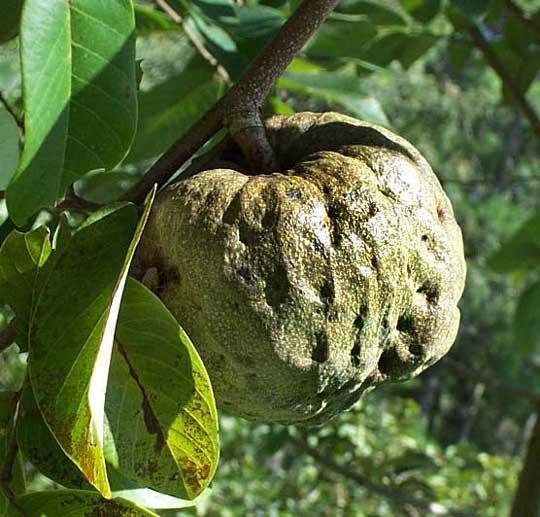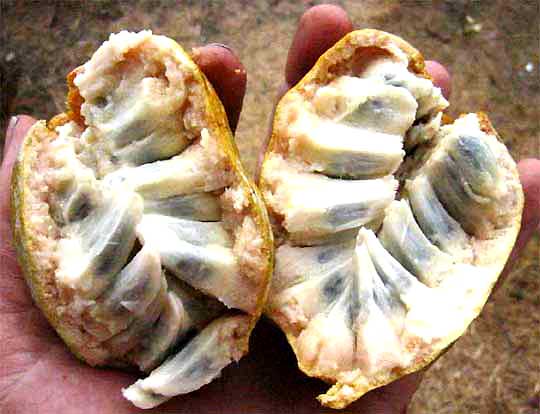Excerpts from Jim Conrad's
Naturalist Newsletter
from the December 17, 2007 Newsletter issued from Yerba Buena Clinic just outside Pueblo Nuevo Solistahuacan, Chiapas, MÉXICO
about 1740 meters in elevation, ± LAT. 17° 11' 27"N, LONG. -92° 53' 35"W
ANONA/ CHERIMOYA
Down below my dwelling in a fencerow next to the garden stands a small tree bearing the 4-inch-wide fruit seen below

People here call that an Anona, and books refer to it as a Cherimoya. It's ANNONA CHERIMOLA. Up north Papaws are members of the same Annona Family and display something of the same texture, same sweet taste, and same big, black, hard seeds embedded in succulent flesh.
You can see that the fruit is dimpled all over with shallow, regularly distributed depressions. These dimples reflect the fact that flowers in this family produce several to many separate pistils, a pistil consisting of a stigma, style and ovary. That's a little unusual, since most flowers produce just one pistil. Blackberry flowers also produce numerous pistils, but when those blossoms are pollinated the many individual pistils mature into juicy little black bags that cluster together to form the blackberry fruit. The Custard-Apple fruit is like that, except that the pistils are more grown together. If you need to review basic flower structure, see my page at www.backyardnature.net/fl_stand.htm.
Therefore, the Cherimoya's dimples coincide with boundaries between the flower's grown-together pistils. Cherimoyas have been grown for so long by so many cultures that many cultivated races have arisen. Fruits range from nearly globular to conical, are dimpled like ours to nearly smooth, and sometimes can be covered with rounded, protruding bodies, or tubercles, marking the original pistils. Smooth-fruited races might be confused with Custard-Apples, except that Cherimoya leaves are velvety below while Custard-Apple leaves are practically hairless.
Cherimoyas are native to the Peruvian Andes but are grown worldwide in subtropical areas for their sweet fruit. Other important, delicious fruits in the same genus Annona are: the spiny Soursop or Guanabana; the Sugar-Apple or Sweetsop whose fruits break apart because the cohering pistils aren't fused together like the Cherimoya's, and; the Custard-Apple, similar to the Cherimoya but lacking the conspicuous dimples and not as delicious.
"Las Plantas Medicinales de México" reports that the fruit's seeds are poisonous and can be pulverized to use as an insecticide.
From the March 3, 2008 Newsletter written in the community of 28 de Junio and issued from a ciber in Pujiltic, Chiapas, MÉXICO:
ANONAS ARE RIPE
Now the anonas are ripe and I'm eating my share of them. You can see a ripe, broken-open fruit below:

You know an anona is ripe when it turns orangish yellow and the flesh yields a little when you squeeze it. As the picture indicates, the thing about eating an anona fruit is that you need to be resigned to spitting out lots of seeds, which are about the size, hardness and slipperiness of persimmon seeds. I suspected that most people here don't rush out and pick the abundant fruits on our numerous trees because of all those seeds and the need to spit them.
However, a properly ripe anona is so delicious that I'm willing to put up with the seeds about once a day. I just find myself a seat with nothing but grass and weeds for about ten feet in front of me, and start smacking and spitting.